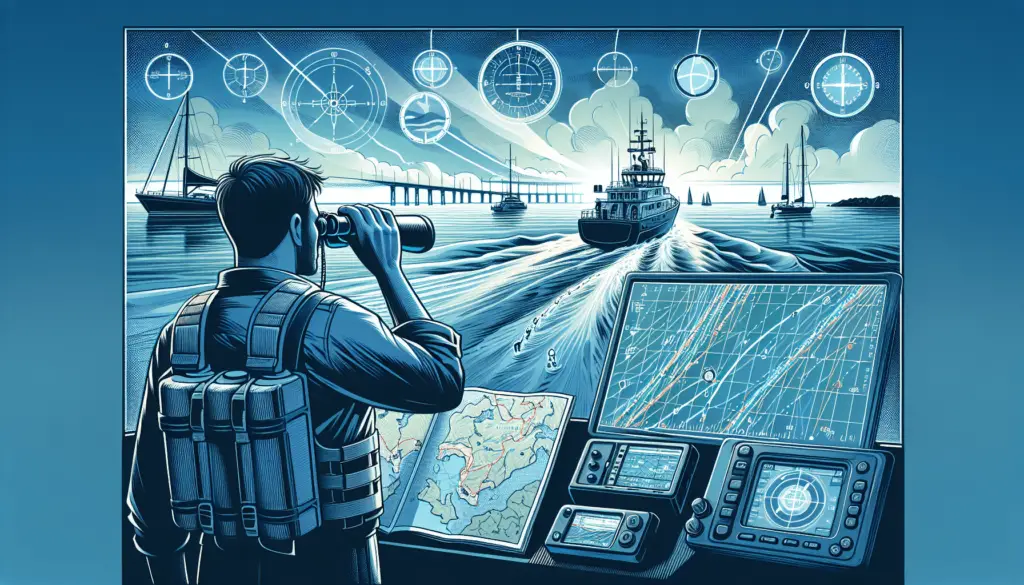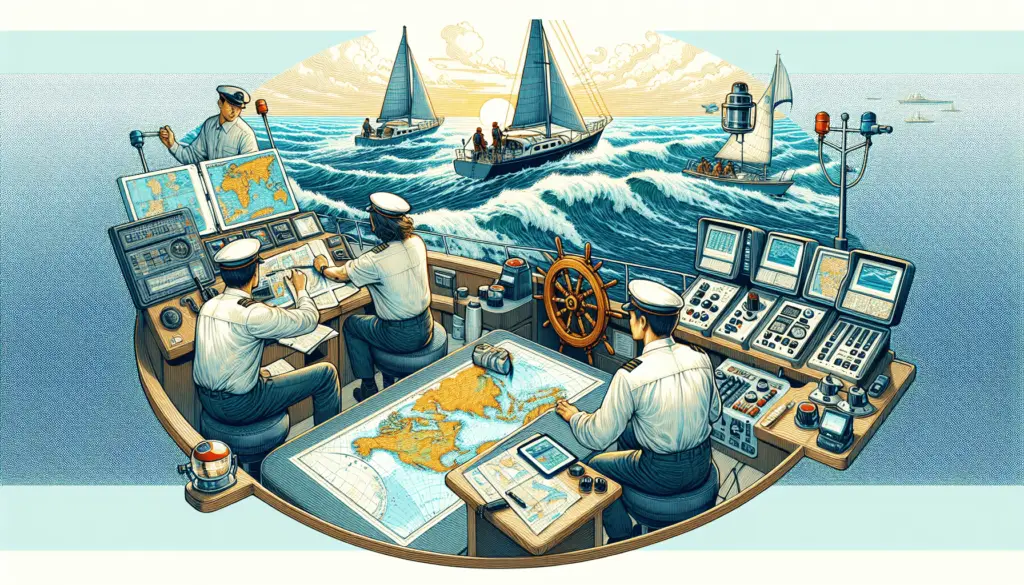Imagine yourself gliding effortlessly on the open water, the breeze gently ruffling your hair, the sun casting long, languid shadows on the crystal surface. Suddenly, your heart lurches with impending doom as another vessel appears seemingly out of nowhere, speeding straight towards your unsuspecting boat. “How To Avoid Collisions On The Water” is a resource that arms you with essential knowledge, tricks, and strategies to mitigate such threats and ensure a safe, enjoyable boating experience. It is your guide through the maze of maritime traffic, helping you navigate tricky waterways with the confidence and precision of a seasoned mariner.
Understanding the Basics of Navigation
Venturing into the blue waves of the open sea is thrilling, but it also requires thoughtful preparation and attention to detail. You, the sailor, must be knowledgeably armed with the fundamental skills of navigation.
Knowing your boat and its handling characteristics
Let’s begin with your vessel, your seafaring partner. Knowing your boat is far more than about understanding its blueprint; it’s about understanding and predicting how your vessel would respond under various conditions. Like a horse-riding knight in battle, you need to feel what your vessel is saying; you should discern the slightest shift in balance or an unusual hum from the motor.
Recognizing markers and channels
Channels are the waterways made for navigation. Identifying markers and channels are vital skills that allow you to traverse the aquatic kingdom confidently and safely. Your eyes should swiftly spot green and red channel markers, and your mind should instantly recall the “red-right-returning” rule to avoid running aground or bumping into other boats.
Following the rules of the nautical road
Sailing on open waters is not as chaotic or lawless as pirate movies portray. There are established rules of the nautical road that you need to follow to ensure an orderly and safe journey. These rules, like terrestrial traffic regulations, govern how vessels should maneuver relative to each other.
Keeping a safe speed
Speed thrills, but when on water, it can also kill. It’s crucial to maintain a safe speed that allows you to respond and maneuver in time to avoid potential hazards. Remember, on water, there are no brakes; your vessel relies on the forces of hydrodynamics and gravity to slow down.
Maintaining Proper Lookout
Being watchful is imperative on the water.
Recognizing the importance of vigilance
Your eyes and ears should always be on high alert, scanning the expansive aquatic ballet for potential threats and beautiful spectacles alike. Vigilance is your first line of defense against collision risks.
Using appropriate binoculars
Binoculars help magnify the vision field. Carry a set of high-quality, waterproof binoculars to trace distant vessels, landmarks, or monsters from the deep. Just kidding about the monsters! But remember, they do not replace the need for a natural eye scan.
Using a crew member as a dedicated lookout when necessary
For long journeys or in particularly complex traffic situations, always have a dedicated lookout to complement the helmsman. This person’s role is to keep an eye out for any unwelcome surprises, while the helmsman focuses on steering the vessel safely.

Utilizing Navigation Lights and Sounds
Lights and sounds are tongues through which vessels communicate in the language of navigation.
Understanding the importance of visible lights
Navigation lights are a boat’s eyes and ears in the dark. They help you understand the direction, position, and nature of other vessels, and signal your presence to them.
Knowing when and how to use sound signals
Sound signals serve to announce your intentions when approaching another vessel or warn of your presence when visibility is poor. Each signal – whether a short blast or a prolonged one – carries a precise meaning.
Using foghorns and other audible aids
Foghorns and other audible aids come to your rescue in conditions of reduced visibility, like fog or heavy rain. Use them to proclaim your presence to other potentially unaware mariners.
Knowing the Right-of-Way Rules
The nautical world, as polite as a gentleman’s club, employs directions about how to pass one another without creating disorder or danger.
Following sailing rules for passing, overtaking, and crossing paths
It’s essential to remember who has the right of way and to act accordingly – whether you’re passing, being overtaken, or crossing paths with another vessel.
Understanding the role of ‘stand-on’ and ‘give-way’ vessels
In the nautical dance, there are always two partners: the ‘stand-on’ vessel, who must maintain its course and speed, and the ‘give-way’ vessel, who needs to steer clear to avoid collision.
Interpreting other vessels’ actions in adherence to these rules
Reflect upon the movements of nearby vessels, verify their actions against known right-of-way rules, and respond appropriately.

Employing Proper Communication
On water, clear communication deciphers chaos into gracefulness.
Learning to use marine VHF radio
The marine VHF radio is an essential tool for connecting with other vessels or with the coast guard. You need to familiarize yourself with its workings to send and receive messages effectively.
Understanding the correct etiquette and language
Just like speaking on professional walkie-talkies, there’s a protocol to follow when speaking on VHF radio. Knowing the right terms, etiquette, and call signs is key to ensuring clear and efficient communication.
Communicating clearly and promptly in potential collision situations
In a potential collision situation, swift and clear communication can often make the difference between peril and safety. Remember to be lucid, brief, and assertive.
Applying Precautionary Measures in Harbors and Congested Areas
The water is not always a vast, solitary expanse. It can sometimes be bustling with activity, demanding additional caution from you.
Being aware of the risks in busy areas
Congested areas, such as harbors or popular boating spots, have a higher traffic density and diverse vessel types, thus requiring enhanced situational awareness.
Reducing speed when necessary
Lowering your speed while navigating through crowded waters gives you more time to respond to unexpected situations and helps maintain safe distances from other vessels.
Keeping clear of large ships and vessels
Large vessels have limited maneuverability and visibility. Thus, make a conscious effort to keep clear of them and ensure that your actions do not impede their course.
Making Effective use of Modern Navigational Tools
Navigation has evolved significantly from the era of stars and sextants, embracing cutting-edge technology to refine its craft.
Radar systems
Radar systems reflect radio waves against objects to ascertain their presence, thus aiding visibility, especially in the dark or in foggy conditions. Master the art of interpreting radar images and alarms to navigate breezily through such situations.
Automatic Identification System (AIS)
AIS allows vessels to ‘see’ and be ‘seen’ digitally. It provides useful data, including position, speed, course, and vessel dimensions, helping you ascertain potential collision risks from ships far off.
Global Positioning System (GPS)
GPS, the knight in shining armor of modern navigation, provides accurate real-time information of your location. Understanding how to interpret GPS data is vital to ensure that you’re on the right course.
Training and Practice for Night and Limited Visibility
Conquering the night and shrouded skies is also a part of your nautical journey.
Becoming familiar with lighted and unlighted buoys at night
At night, the world transforms into a different realm altogether. Learn to identify the glow of lighted buoys and engage your imagination to visualize unlit ones.
Learning to recognize lights on other vessels
Not all lights you see on the sea belong to stars or shore. Vessels too shimmer on the landscape. Decoding these twinkles can help predict the course of other ships and avoid potential dangers.
Using electronic navigation aids effectively at night
Make good use of electronic aids like radar, AIS, and GPS, which are especially beneficial during nighttime when visibility is reduced.
Appreciating the Importance of Weather Monitoring
Weather is an uncontrollable actor that can dramatically influence your voyage.
Understanding how weather conditions affect visibility
Weather metamorphoses the panorama. Dense fog, heavy rain, or the dark of night can shroud potential hazards, making it imperative to alter your sailing style accordingly.
Monitoring the weather constantly
The sea has a reputation for unpredictable mood swings. A sunny day can morph into a stormy night swiftly. Regularly monitor the weather through forecasts and keep an eye on changing atmospheric conditions.
Taking necessary steps before adverse weather strikes
Your action or inaction in adverse weather could become the difference between a safe harbor and a disastrous voyage. Secure all loose gear, veer off to a safe course, and inform relevant authorities if required.
Understanding Emergency Procedures
Despite meticulous planning and precautions, emergencies can occur. It’s paramount to be prepared for when they do.
Knowing when and how to send out distress signals
In distress situations, your lifeline is signaling your situation effectively to potential rescuers. Enhance your knowledge about distress flares, EPIRBs, and how to send Mayday messages via VHF radio.
Carrying out drills and practicing emergency response
Drills instill procedures into muscle memory. Conduct regular safety drills for man-overboard, fire, and evacuation scenarios. You can never be too prepared!
Having a proper understanding of lifesaving equipment
A lifesaver in an emergency is knowing how to use lifesaving equipment like life jackets, lifeboats, and liferafts. Familiarize yourself with their handling procedures to ensure you can use them swiftly and efficiently, if need be.
And with that, dear sailor, you’re ready to embark on your seafaring adventure. By employing these pointers, you’ll have the tools necessary to prevent collisions and ensure safe and enriching journey on the water. Embrace your role as a patron of the sea, and gif it the respect it deserves. Bon Voyage!

